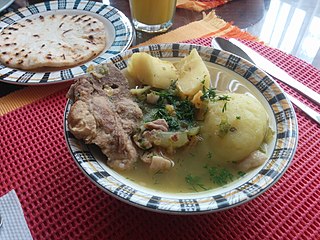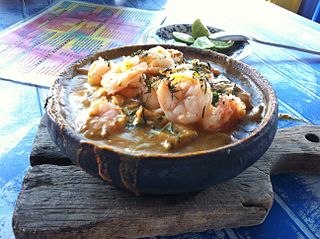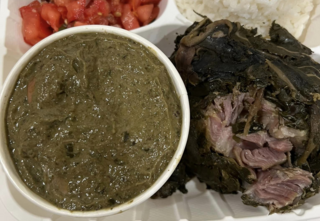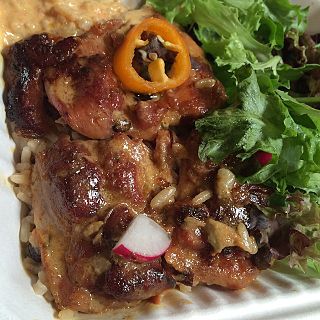 Plated oil down | |
| Type | Stew |
|---|---|
| Place of origin | Grenada |
| Main ingredients | Breadfruit, salted meat or chicken, coconut milk, spices |
| Variations | seafood |
Oil down is a salted meat and vegetable stew that is the national dish of Grenada. [1]
 Plated oil down | |
| Type | Stew |
|---|---|
| Place of origin | Grenada |
| Main ingredients | Breadfruit, salted meat or chicken, coconut milk, spices |
| Variations | seafood |
Oil down is a salted meat and vegetable stew that is the national dish of Grenada. [1]
Oil down is a stew of breadfruit, salted meat, chicken, dumplings, callaloo, and other vegetables stewed in coconut milk, herbs, and spices. [2] [3] The name refers to the fact that the oil from the coconut milk used in cooking is either absorbed by the ingredients or settles to the bottom of the cooking pot. [4] All of the liquid is cooked down (dried out), hence the name oil down. [5]

The term "oil down" is also used for a traditional neighborhood party at which the stew is prepared and eaten. Traditionally it is the men who cook the oil down at such parties. [4] Oil down is also very popular in local restaurants. [3]
There is no set recipe for oil down, as each household and each parish makes it to suit their preference. [5]
Unlike most stews, in which the ingredients get a thorough mixing during the cooking process, a pot of oil down is "packed." Exactly how to "pack the pot" is a matter of taste and tradition, as well as a subject of occasional controversy. Everyone has a different order and method, but usually the breadfruit and meat goes on the bottom, most of the vegetables in the middle, and the callaloo leaves and dumplings on top. The ingredients simmer in situ. [6]
— Scott Neuman, N.P.R. News
Traditionally, the dish is finished when all the liquid has been absorbed, which usually takes at least an hour, depending on the size of (the) pot. [7]
— "Meat Loves Salt" blog
Oil down is not unique to Grenada. It is also popular in nearby Trinidad and Tobago, which shares a long history of cultural influences with Grenada. There are differences in how each island makes its oil down, however, with Grenadians preferring dasheen, dumplings, and turmeric while Trinidadians tend toward a simpler dish without dumplings, but with hot peppers. [8] There are different versions of this stew in other Caribbean countries as well. In Guyana a similar stew is called mettagee, or mettem, [9] [10] and in Jamaica there is a seafood version called run down. [11]

Caribbean cuisine is a fusion of West African, Creole, Amerindian, European, Latin American, Indian/South Asian, North American, Middle Eastern, and Chinese. These traditions were brought from many countries when they moved to the Caribbean. In addition, the population has created styles that are unique to the region.
Jamaican cuisine includes a mixture of cooking techniques, flavours and spices influenced by Amerindian, African, Irish, English, French, Portuguese, Spanish, Indian, Chinese and Middle Eastern people who have inhabited the island. It is also influenced by the crops introduced into the island from tropical Southeast Asia, many of which are now grown locally. A wide variety of seafood, tropical fruits and meats are available.

Trinidad and Tobago has a unique history and its food is influenced by Indian-South Asian, West African, Creole, European, American, Chinese, Amerindian, and Latin American culinary styles. Trinidadian and Tobagonian food is dominated by a wide selection of dishes, most notably, doubles, roti, pelau, callaloo and curried crab and dumplings. Trinidad and Tobago is also known for its prepared provisions, such as dasheen, sweet potato, eddoes, cassava, yam, soups and stews, also known as blue food across the country. Corresponding to the Blue Food Day event held annually in Trinidad and Tobago.

Peasant foods are dishes eaten by peasants, made from accessible and inexpensive ingredients.

Callaloo is a plant used in popular dishes in many Caribbean countries, while for other Caribbean countries, a stew made with the plant is called callaloo. Cuisines including the plant Callaloo or dishes called callaloo varies throughout the Caribbean. In countries such as Trinidad and Tobago or Grenada, the dish itself is called callaloo, and uses taro leaves or Xanthosoma leaves.

Sancocho is a traditional stew in Canarian cuisine and several Latin American cuisines. Latin variations represent popular national dishes in Dominican Republic, Colombia, Cuba, Honduras, Mexico, Ecuador, Panama, Puerto Rico, Trinidad and Tobago, and Venezuela. It usually consists of large pieces of meat, tubers and vegetables served in a broth.

Levantine cuisine is the traditional cuisine of the Levant, in the sense of the rough area of former Ottoman Syria. The cuisine has similarities with Egyptian cuisine, North African cuisine and Ottoman cuisine. It is particularly known for its meze spreads of hot and cold dishes, most notably among them ful medames, hummus, tabbouleh and baba ghanoush, accompanied by bread.

Pepper Pot is a thick stew of beef tripe, vegetables, pepper and other seasonings. The soup was first made in West Africa and the Caribbean before being brought to North America through slave trade and made into a distinctively Philadelphian dish by colonial Black women during the nineteenth century.
Grenada's French colonists brought their culture, as did the African slaves they brought across the Atlantic for agricultural work. Indians have also influenced the island culture in more recent years.

Pepperpot is an Amerindian-derived dish popular in Guyana. It is traditionally served at Christmas and other special events. Along with chicken curry, and cook-up rice, pepperpot is one of Guyana's national dishes.
Green bananas are unripe bananas used in cuisines worldwide. They have a firmer texture and a starchy, mildly astringent taste compared to their ripe counterparts.

Cazuela is the common name given to a variety of dishes, especially from South America. It receives its name from the cazuela – traditionally, an often shallow pot made of unglazed earthenware used for cooking. The ingredients and preparation vary from region to region, but it is usually a mid-thick flavoured stock obtained from cooking several kinds of meats and vegetables mixed together.
Saint Lucian cuisine is a combination of French, East Indian and British dishes. Before colonization, the Caribs and the Arawaks occupied the island, surviving on its various natural fruits and vegetables like mangoes, oranges, tangerines, avocados, and breadfruits.
The Cayman Islands are a group of islands situated in the Caribbean Sea just between Cuba and Honduras. After being colonized first by Jamaica and then by the British, Cayman Islands remained under British dependency since 1962. Traditional Cayman Islands cuisine is very tied to Jamaican cuisine and they also kept British influences in their cooking, but you can as well find a large variety of international dishes with a local twist. As for traditional dishes the main ingredients are coconut, plantain, cassava, yams, rice and peas. Jamaican cuisine enriched Cayman’s cuisine by offering a large variety of spices such as jerk, curry and other exotic seasonings. The humid soil provides a large variety of exotic fruits and vegetables such as yellow squash, avocados, callaloo, cassava, calabash, spring onions, pineapples, tomatoes, peas, chili, peppers a great range of citrus fruits such as oranges, lemons, limes, grapefruits, bananas and plantains, sweet potatoes, yams and mangoes.

Run down, also referred to as rundown, run dun, rondón, fling-me-far, and fling mi for, is a stew dish in Jamaican cuisine and Tobago cuisine. The traditional Jamaican dish is eaten in several Latin American countries that share a coast with the Caribbean Sea.

Lūʻau, Luʻau, Laulau, Lū, Rourou, Rukau, Fāfā, Hāhā, and Palusami are all related dishes found throughout Polynesia based on the use of taro leaves as a primary ingredient. While taro generally is known as a root vegetable for its starchy corms, the leaves are consumed as well. The base recipe is vegetarian. Most often, coconut milk was added, and later meat or seafood. The texture of the dish range from a thick soup to a dense cake.

A stew is a combination of solid food ingredients that have been cooked in liquid and served in the resultant gravy. Ingredients can include any combination of vegetables and may include meat, especially tougher meats suitable for slow-cooking, such as beef, pork, venison, rabbit, lamb, poultry, sausages, and seafood. While water can be used as the stew-cooking liquid, stock is also common. A small amount of red wine or other alcohol is sometimes added for flavour. Seasonings and flavourings may also be added. Stews are typically cooked at a relatively low temperature, allowing flavours to mingle.
Stew peas is a Jamaican stew prepared using coconut milk, beans and salted meat. It is a common dish in Jamaica.

Pelau is a traditional rice dish from the West Indies. Its main ingredients typically include meat, rice, pigeon peas or cowpeas, coconut milk and sugar. Various vegetables and optional spices can be added. Common spices used in the dish are cardamom, cloves, cumin, and coriander. The meat is caramelised in brown sugar along with onion and garlic and the other ingredients are then added one by one, resulting in a dark brown stew.